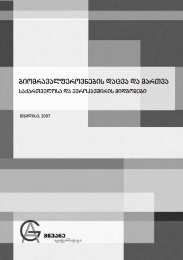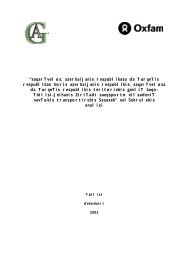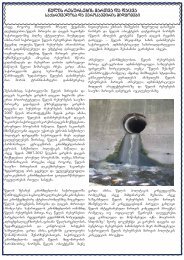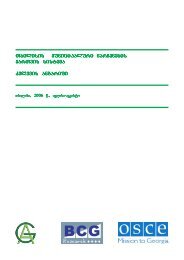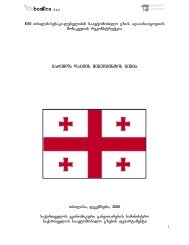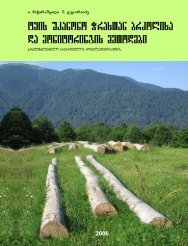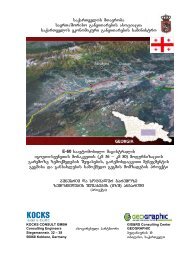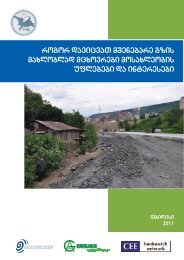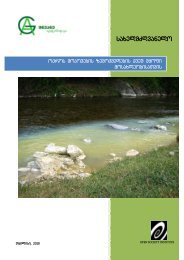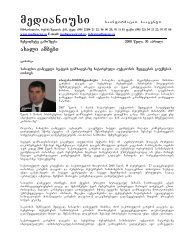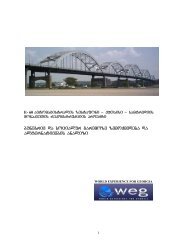Part I
Part I
Part I
You also want an ePaper? Increase the reach of your titles
YUMPU automatically turns print PDFs into web optimized ePapers that Google loves.
Draft Black Sea Regional Transmission Project ESIA<br />
2.0 THE PROPOSED PROJECT LINE AND ALTERNATIVES<br />
This chapter describes the proposed transmission line and several alternatives. The action<br />
alternatives include the regional project as described in Chapter 1 and also modified corridor<br />
routes to reduce impacts on protected areas. The alternatives considered include three<br />
action alternatives and the no action alternative:<br />
<br />
<br />
<br />
<br />
Alternative 1: completion of the 500kV line as proposed in the late 1980s and partly<br />
constructed through 1991, plus a new substation at Akhaltsikhe and a new 400kV<br />
line to the Turkish border. Construction would begin in 2010 and last through 2012.<br />
Alternative 2: the same as Alternative 1 except a modified route near Ktsia-<br />
Tabatskuri Managed Reserve and through Borjomi-Kharagauli National Park.<br />
Alternative 3: the same as Alternative 2 except a modified route that does not cross<br />
Borjomi-Kharagauli National Park.<br />
Alternative 4: No action. This alternative would involve not completing the line but<br />
instead leaving the foundations and towers as they are, and not completing the Black<br />
Sea Regional Transmission Project described in Chapter 1.<br />
2.1 Alternative 1: Black Sea Regional Transmission Project<br />
This alternative includes the following key elements as shown on Figure 1-1 in Chapter 1:<br />
<br />
<br />
<br />
<br />
Rehabilitation and/or construction of approximately 260 kilometers of 500kV<br />
transmission line connecting the existing 500kV substations at Zestaphoni and<br />
Gardabani.<br />
Construction of a new 500/400 kV and 400 kV substation at Akhaltsikhe.<br />
Approximately 30 kilometers of 400 kV transmission line from the new substation<br />
at Akhaltsikhe to the Turkish border (to be connected to the Borchka substation in<br />
Turkey at a later date).<br />
Expansion of the substations at Zestaphoni and Gardabani to accommodate the<br />
new 500kV circuit.<br />
Work on strengthening the transmission network in the Caucasus began in the 1980s. The<br />
proposed 500 kV line that is the subject of this ESIA was originally designed as part of a<br />
larger plan to connect the electricity systems of Russia and all three Trans-Caucasian<br />
Republics, and to improve reliability of the Georgian power system. Construction of the<br />
section from Gardabani to Zestaphoni started in 1989 and continued until 1991. However,<br />
after 1992 further construction became impossible due to political events in Georgia, and<br />
sections of the line whose foundations and towers had been constructed were left<br />
unenergized and unprotected. The project that was partly constructed at that time is now<br />
proposed to be completed and extended. The proposed project would extend Georgia’s<br />
main 500kV system by adding two new 500kV links from Gardabani and Zestaphoni to<br />
a new substation near Akhaltsikhe. The new Akhaltsikhe substation will be connected to<br />
the Turkish grid at Borchka using a 400kV overhead line. The 400kV line from the Georgian<br />
border to Borchka in Turkey has not yet been designed or constructed. A companion project<br />
to facilitate the transit element is the completion of a new 500kV connection between<br />
Georgia and Azerbaijan, which is also to be completed at a later date.<br />
Before construction was ended in 1991, a total of 554 foundations and towers were<br />
constructed over the 283-kilometer corridor. Table 2-1 shows the status of the existing<br />
towers. Of these, slightly over half will need rehabilitation of some sort, ranging from<br />
complete replacement to repairs to existing tower components. The proposed project will<br />
12



